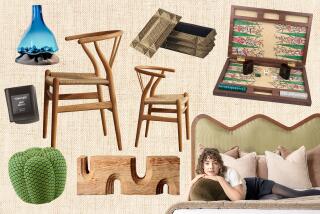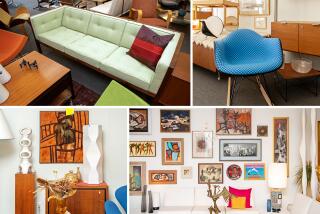Vintage Kitchen Items Are Cooking Up Interest
Home cooks have always looked for the latest gadgets to use in the kitchen. All types of peelers, slicers and graters have been made in the past few hundred years.
Many early kitchen utensils were handmade. A pierced piece of tin was a grater, and a curved piece of tin was used to core an apple. A series of wooden wheels and gears helped to peel an apple.
There are tools to beat eggs, mash potatoes, grind spices, grind meat, scoop ice cream, cut, pare, peel, ladle, skim and stir.
All types of kitchen utensils are collectible, from the old, handmade items to the manufactured iron, tin, aluminum and plastic wares.
*
Question: My armless wicker rocking chair has a diamond design on the back. A label on the bottom says, “Sheboygan Reed and Fiber Furniture Co., Sheboygan, Wisconsin.” When was it made?
*
Answer: Your armless rocker, called a nursing rocker or sewing rocker, dates from the 1920s. It was made from machine-woven art fiber--chemically treated twisted paper--rather than from hand-woven reeds. The machine and fiber process was invented in 1917.
*
Q When I was a kid during the Depression, my father made a rocker and carved a Mickey Mouse head on the back. He painted it, and it looks just like Mickey. Is a homemade Disney toy as collectible as the ones the company licensed?
*
A. Your dad wasn’t the only parent who tried making his kids happy on a tight budget. Lots of cartoon fans made--and continue to make--Disney character dolls, rugs, furniture and toys for their own amusement.
Disney once licensed a McCall’s pattern for Mickey and Minnie dolls.
Many well-made homemade items change hands at flea markets.
*
Q. I have a Sandwich-style glass plate by the Duncan-Miller company. Long ago I heard I should look for a diamond-H mark in the design around the rim. I don’t see it. Why not?
*
A. Several Depression glass designs were inspired by the Sandwich Glass Co. in Sandwich, Mass., in the 19th century. Anchor Hocking, Indiana Glass, and Duncan-Miller made the most common examples in the 1920s and ‘30s.
A.H. Heisey & Co. made a plate, called “the Eagle plate,” with a similar design. It was reputed to have a diamond-H--the company’s mark--in the design around the rim, but that is not the case. Research revealed that the “mark” is just a flaw in the mold.
The confusion between Heisey and Duncan-Miller designs probably comes from the fact that A.H. Heisey worked for his father-in-law, George Duncan, before starting his own company.
Heisey first produced Sandwich-inspired designs in 1925. Consumers were starting to show interest in antiques, and authentic Sandwich glass was very popular.
Heisey received a gift of some original mahogany models used to make Sandwich’s glass molds. Heisey’s company used the models as inspiration for their own designs. In 1928 they were pictured in the company newsletter. The story of Heisey’s models is a mystery. The company shipped its collection to an exhibition out West and it disappeared en route, never to be seen again.
*
Q. Mother bought my dishes in 1948. She was told that they were 100 years old. The mark on the back pictures a crown above a shield that is decorated with an arm in armor holding a sword.
*
A. Your dishes were not 100 years old in 1948.
Springer & Co. of Elbogen, Bohemia--now Loket in the Czech Republic--used the mark you describe from 1891 to 1918.
The company made decorative porcelain, table sets, laboratory porcelain and figurines. The factory, which changed names and marks after World War I, went out of business in 1945.
If you’d like a listing of helpful books and publications on antiques, send a self-addressed, stamped (55 cents) envelope to the Kovels, Los Angeles Times, King Features Syndicate, 235 E. 45th St., New York, NY 10017.
(BEGIN TEXT OF INFOBOX / INFOGRAPHIC)
Current Prices
Prices are recorded from antiques shows, flea markets, sales and auctions throughout the United States. Prices vary because of local economic conditions.
* Rolling Rock advertising figure, horse rearing up, plaster, raised letters on base, 1960s, 11 inches: $65.
* Lake Placid Winter Olympics plate, 1980, glass, Roni the Raccoon mascot, 11 inches: $150.
* Glass cruet, Greentown chocolate, Leaf Bracket pattern, original stopper: $190.
* Madame Alexander “Alice in Wonderland” doll, Alexanderkin, straight-leg walker, 1954, 8 inches: $220.
* Shaving mug, double fraternal, emblems for Odd Fellows and Knights of Pythias, names in gold: $225.
* American mahogany and rosewood neoclassical piano, recessed keyboard, carved legs, manufactured by Samuel Neilson, New York, 69 by 27 by 36 inches: $475.
* Graniteware refrigerator bowls, red swirl, 1960s, set of four: $585.
* Buddy “L” truck and trailer, advertising Allied Van Lines, black and orange, 29 inches: $775.
* Roycroft desk box, hinged lid over inkwell, stamp holder, tooled floral design, marked, 7 1/2 by 4 1/2 by 1 1/2 inches: $990.
* Jim Payne fly-fishing rod, No. 102-L, 8 feet: $2,200.


